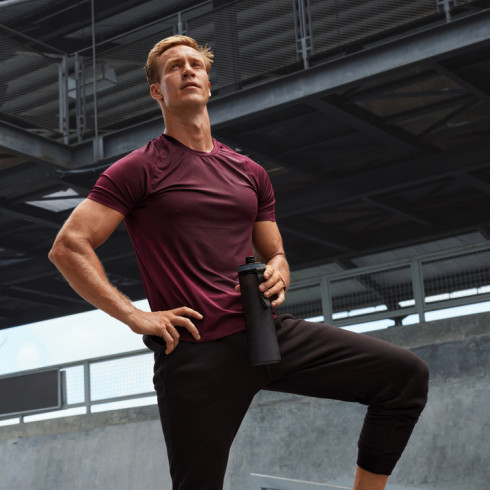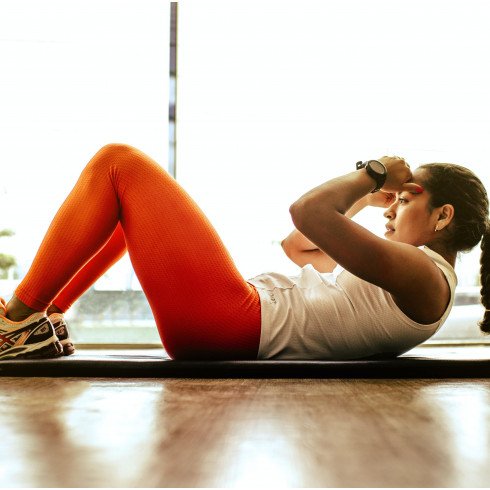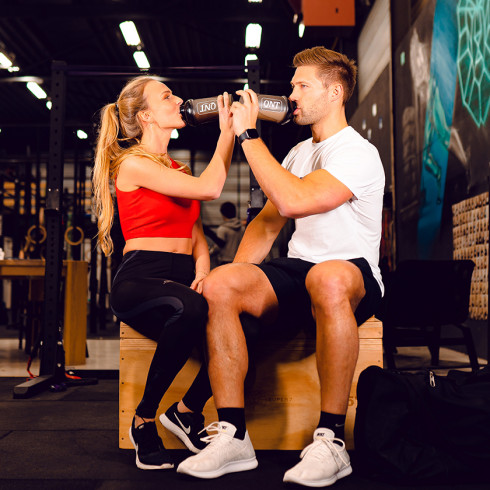Boosting Your Cycling Performance: The Keys to Success
TABLE OF CONTENTS
Understanding the different phases of cycling training
To progress in cycling, it is essential to structure your training into several distinct phases, each with specific objectives.
- Base endurance phase: This phase focuses on improving your aerobic capacity, which is your ability to sustain moderate effort over a long period. The rides are long and performed at moderate intensity (60-70% of your maximum heart rate). This solid foundation is crucial for the other training phases.
- Strength development phase: The emphasis is on muscle strengthening and the ability to generate more power on the bike. Sessions include hill climbs, uphill sprints, and muscle resistance exercises. This phase is particularly important if you participate in races with climbs or intense efforts.
- Speed and power phase: Here, the goal is to improve your ability to ride at high speeds on flat or slightly hilly terrain. Training sessions include high-intensity intervals (HIIT) and sprints on short, intense segments. This phase develops your anaerobic capacity, which is essential for explosive efforts.
- Active recovery phase: This phase is essential to allow your body to recover while maintaining a level of activity. It includes light rides, rest days, and low-intensity exercises to help your muscles repair without adding extra stress.
The importance of warm-up and recovery for cyclists.
A proper warm-up and effective recovery are key elements in preventing injuries, improving your performance, and maximizing the benefits of each training session.
- Warm-up: Before each ride, a 10- to 15-minute low-intensity warm-up is recommended. This helps increase your body temperature, stimulate blood flow to the muscles, and prepare your cardiovascular system for the effort. The warm-up can include arm rotations, lunges, and dynamic movements to prepare your body for the efforts ahead.
- Recovery: After training, recovery helps bring your body back to its resting state and reduce muscle tension. This includes a cool-down period with 10 to 15 minutes of light pedaling to flush out the metabolic waste accumulated in the muscles. Static stretching after the ride, as well as active recovery techniques like foam rolling, are also essential to promote muscle repair and reduce soreness.
- Recovery between sessions: To optimize recovery, it is important to include rest days or active recovery sessions between intense workouts. This allows your muscles to regenerate and prevents overtraining, which can lead to injuries and decreased performance.
Varying ride types to progress in cycling.
Variety in ride types is essential to stimulate physical adaptations and avoid performance stagnation.
- Long and moderate rides: These rides are crucial for building your endurance and training your body to maintain prolonged effort. They are generally done at a moderate intensity and over longer distances than your usual rides.
- Interval sessions: To improve your speed and power, interval sessions are indispensable. They consist of intense effort intervals followed by recovery periods. For example, you could alternate between 2 minutes of intense pedaling and 3 minutes of recovery, repeated several times.
- Hill climbs: Hill rides are perfect for strengthening your leg muscles and improving your power. They also allow you to work on your pedaling technique under increased resistance.
- Recovery rides: These low-intensity rides help improve blood circulation without fatiguing your muscles. They are ideal after an intense training session or a competition.
- Technical work: Dedicate some rides to improving your pedaling technique, mastering descents, or handling turns to bring significant benefits to your overall performance.
How to avoid common injuries in cyclists
Injuries are a common risk for cyclists, especially when you increase your training load. Here's how to prevent them.
- Bike fit: A poor bike fit is a frequent cause of injuries. Make sure the saddle height, handlebar position, and crank length are properly adjusted to your body shape. A professional bike fitting can prevent knee, back, and shoulder pain.
- Muscle strengthening: Incorporate muscle strengthening exercises, particularly for the core, hips, and legs, to support your joints and stabilize your body on the bike, thus reducing the risk of injury.
- Gradual progression: Avoid increasing the distance, frequency, or intensity of your rides too quickly. Follow the golden rule of not increasing your training volume by more than 10% per week to allow your body to adapt.
- Rest and recovery: Overtraining is a major cause of injuries. Give your body time to recover between intense sessions, and don't overlook the importance of rest days in your training program.
- Listening to your body: Learn to recognize the early signs of overtraining or injury, such as persistent pain or unusual fatigue. If you feel pain, it's better to reduce the intensity or take a rest day to prevent the injury from worsening.
By incorporating these principles into your training routine, you can not only improve your cycling performance but also ride more safely and sustainably, minimizing the risk of injuries.
STRUCTURING YOUR CYCLING TRAINING PROGRAM.
To progress effectively in cycling, it is essential to structure your training program strategically. A well-designed program will help you reach your goals, whether in terms of power, speed, endurance, or overall fitness. Here's how to structure a complete and personalized program to maximize your performance on the bike.
Developing a personalized training plan based on your goals
A personalized training plan is key to reaching your cycling goals, whether it's participating in a competition, improving your fitness, or simply enjoying your rides more.
- Define your goals: Start by setting clear and specific goals. For example, you might aim to improve your time on a specific course, increase your average power, or prepare for an event like a gran fondo or triathlon. Make sure your goals are SMART (Specific, Measurable, Achievable, Realistic, and Time-bound).
- Assess your current level: Before designing your plan, assess your current fitness level. This can include power tests (FTP – Functional Threshold Power), evaluating your endurance during long rides, or an overall fitness assessment.
- Structure the training phases: Divide your plan into distinct phases, each with a specific objective. For example, start with a base endurance phase, move on to a strength and power development phase, and finally, a refinement phase leading up to a competition or specific goal.
- Plan progression: Gradually increase the training load in terms of duration, intensity, and frequency. Follow the 10% rule to avoid overtraining: do not increase the training volume by more than 10% per week. Also, integrate active recovery periods to allow your body to adapt and prevent overtraining.
- Flexibility and adjustments: Be ready to adjust your plan based on your progress, how you feel, or any unforeseen events. Flexibility is essential to maintaining motivation and preventing injuries.
Include interval sessions to improve power and speed.
Interval sessions are crucial for increasing your power on the bike and improving your ability to maintain high speeds, especially during races or intense rides.
- Basic concept: Intervals involve alternating periods of intense effort with periods of active recovery. This method stimulates both the aerobic and anaerobic systems, thereby improving your ability to sustain high efforts over prolonged periods.
Types of interval sessions:
- Short sprints: Short intervals of 20 to 30 seconds at maximum power, followed by 2 to 3 minutes of active recovery. These sessions increase your maximum power and explosiveness.
- Long intervals: Efforts of 3 to 5 minutes at an intensity close to your anaerobic threshold, followed by 2 to 3 minutes of recovery. They are effective for improving your high-intensity endurance.
- Hill climbs: Performing intervals uphill strengthens your leg muscles and improves your hill-specific power, a valuable asset for mountain cyclists.
- Frequency and progression: Incorporate interval sessions 1 to 2 times per week, gradually increasing the intensity and duration of the intervals as your fitness improves.
Work on endurance for long bike rides.
Endurance is a fundamental element for any cyclist, whether it's participating in long-distance races, rides, or simply improving your overall fitness.
- Long and regular rides: Plan long-duration rides, usually at a moderate intensity (60-75% of your maximum heart rate). These rides should be regular and progressive, gradually increasing the distance over the weeks.
- Aerobic zone focus: Endurance rides focus on developing your aerobic zone, which improves your body’s ability to use oxygen to produce energy. This translates to better energy efficiency and reduced fatigue during long rides.
- Vary the terrain: To prepare for varied races, alternate between flat, hilly, and mountainous routes. This helps your body adapt to different types of terrain and conditions.
- Effort management: Learn to manage your effort over long distances using a power meter or heart rate monitor. Maintain a steady pace and avoid unnecessary effort spikes that could deplete your energy reserves too early.
- Nutrition and hydration: On long rides, it's essential to eat and hydrate properly to maintain performance. Bring carb-rich snacks and isotonic drinks to avoid energy drops.
Incorporate strength training exercises specific to cyclists.
Muscle strengthening is often overlooked by cyclists, but it plays a crucial role in improving performance and preventing injuries.
- Targeted exercises: Focus on key muscle groups for cycling, including the quadriceps, hamstrings, glutes, lower back, and core muscles. Exercises like squats, lunges, calf raises, and planks are particularly effective.
- Frequency: Incorporate strength training sessions 2 to 3 times a week. Avoid doing them on days with intense rides to prevent excessive muscle fatigue. Sessions can be done with free weights, machines, or simply using your body weight.
- Injury prevention: A strong and stable core helps maintain good posture on the bike, reducing the risk of back and knee pain. Strengthening the hips and glutes improves pedaling stability and efficiency.
- Mobility work: In addition to strengthening, include mobility and stretching exercises to improve flexibility and prevent muscle tightness. Good mobility in the hips, ankles, and shoulders is essential for smooth and efficient pedaling.
- Functional exercises: Incorporate movements that mimic cycling actions, such as hip extensions in the pedaling position, to improve coordination and cycling-specific power.
By structuring your cycling training program around these principles, you can maximize your performance, achieve your specific goals, and ride stronger, longer, and with less risk of injury.
ADAPTED NUTRITION TO OPTIMIZE CYCLING PERFORMANCE.
Proper nutrition is fundamental to optimizing your performance in cycling, whether it’s to support your efforts during training, maximize your energy during competitions, or promote quick and effective recovery after each ride. Here's how to structure your diet to meet the specific needs of cycling.
Essential nutrients to support effort in cycling.
To perform well in cycling, it's crucial to consume the right nutrients that support both prolonged physical effort and muscle recovery.
- Carbohydrates: They are your main source of energy to sustain your efforts. Carbohydrates provide the fuel needed for prolonged and intense efforts. Complex carbohydrates, such as whole grains, pasta, brown rice, and starchy vegetables, should make up a significant portion of your diet. Before a competition, "carb-loading" can be beneficial to saturate your glycogen stores.
- Proteins: Proteins play a key role in repairing and rebuilding muscles used during cycling. Consume lean protein sources like white meat, fish, eggs, legumes, and dairy products to support muscle recovery after exercise.
- Fats: Healthy fats, such as those found in avocados, nuts, seeds, and vegetable oils, provide a long-lasting energy source, especially during long rides. They are also important for the absorption of fat-soluble vitamins (A, D, E, K) and for maintaining cellular functions.
- Vitamins and minerals: Cyclists have increased needs for vitamins and minerals, particularly iron (for muscle oxygenation), calcium and vitamin D (for bone health), and magnesium (for muscle function). Make sure to include a wide variety of fruits, vegetables, and dairy products in your diet.
- Antioxidants: Antioxidants help reduce inflammation and speed up recovery by neutralizing free radicals produced during intense exercise. Eat colorful fruits and vegetables, such as berries, spinach, and carrots, for their antioxidant content.
What to eat before a bike ride or competition.
What you eat before a ride or a competition can have a significant impact on your performance. It is important to plan your nutrition well to ensure you have enough energy without overloading your digestive system.
- Meal timing: It is recommended to consume a carbohydrate-rich meal 3 to 4 hours before the ride or competition. This meal should be balanced, consisting of complex carbohydrates, lean proteins, and healthy fats. For example, a bowl of oatmeal with fruits and yogurt, or whole wheat pasta with chicken and vegetables.
- Pre-race snack: About 30 to 60 minutes before the start, a light snack rich in simple carbohydrates and low in fiber is ideal for providing a quick energy boost. Options like a banana, whole wheat bread with honey, or a low-fiber energy bar are good choices.
- Avoid common mistakes: Avoid fiber-rich, fatty, or protein-heavy foods right before exertion, as they can slow digestion and cause digestive discomfort during the ride. Likewise, avoid eating too close to the start to prevent feeling heavy or bloated.
- Pre-ride hydration: Drink enough water in the hours leading up to the ride to stay well-hydrated. However, don't consume too many liquids right before the start to avoid feeling heavy.
Post-ride nutrition for quick and effective recovery.
Post-ride recovery is crucial to restoring your energy reserves, repairing the muscles used, and preparing your body for the next efforts.
- Metabolic window: The 30 to 60 minutes following a ride is a key period for recovery, called the metabolic window. During this time, your body is particularly receptive to nutrients, promoting muscle repair and glycogen replenishment. Consume a meal or snack with a good balance of carbohydrates and proteins.
- Carbohydrates and proteins: A 3:1 ratio of carbohydrates to proteins is recommended to optimize recovery. For example, a smoothie made with banana, milk or yogurt, and oats is an ideal option for quick recovery. The carbohydrates replenish glycogen stores, while the proteins aid in muscle repair.
- Post-ride meal: Within two hours of the ride, consume a complete meal that includes lean proteins, complex carbohydrates, and vegetables. An example of a meal could be salmon with quinoa and grilled vegetables.
- Hydration after exercise: After the ride, rehydrate with water or a recovery drink containing electrolytes to replace the minerals lost through sweat. Proper hydration also helps eliminate toxins and reduce muscle soreness.
- Antioxidants for recovery: Include foods rich in antioxidants, such as berries, spinach, or almonds, to help reduce inflammation and speed up muscle recovery.
Hydration: maintaining your performance on long distances.
Hydration is a crucial aspect of maintaining your performance in cycling, especially during long rides where dehydration can quickly harm your endurance and power.
- Hydration needs: As a general rule, it is recommended to drink about 500 ml of water 2 hours before the ride, then continue to hydrate regularly throughout the effort. During exercise, aim to consume about 150 to 250 ml of water or isotonic drink every 20 to 30 minutes, depending on the intensity of the effort and weather conditions.
- Electrolytes: On rides longer than an hour, or in hot and humid conditions, it is important to replace the electrolytes lost through sweat. Isotonic drinks containing sodium, potassium, and magnesium are ideal for maintaining electrolyte balance and preventing muscle cramps.
- Monitoring hydration: Be mindful of signs of dehydration, such as excessive thirst, fatigue, dizziness, or reduced urine output. The color of your urine can be a good indicator of hydration: it should be clear or slightly yellow.
- Hydration after the ride: Continue drinking water after the ride to replace lost fluids. If you've sweated heavily, a recovery drink containing electrolytes can help restore fluid balance and speed up recovery.
By adopting an appropriate nutritional approach and hydrating properly, you can not only improve your cycling performance but also optimize your recovery, allowing you to continue progressing sustainably.
ADAPTING YOUR NUTRITION TO YOUR CYCLING GOALS.
Adapting your nutrition based on your specific cycling goals is crucial for optimizing your performance, whether you're looking to lose weight, improve endurance on long rides, or maximize your recovery and energy with the help of supplements. Here's how to adjust your diet to reach your goals effectively and sustainably.
Nutrition for weight loss in cyclists.
Losing weight while maintaining optimal cycling performance requires a balanced nutritional approach that reduces body fat while supporting your physical efforts.
- Moderate calorie deficit: To lose weight, it's essential to create a calorie deficit, meaning consuming fewer calories than you burn. However, this deficit should be moderate (about 300 to 500 calories per day) to avoid muscle loss and a decrease in performance. The goal is to lose weight gradually to minimize the impact on the energy available for training.
- Focus on nutrient-rich foods: Consume foods rich in nutrients but low in calories to maximize satiety while reducing calorie intake. Vegetables, fruits, lean proteins (such as chicken, fish, or legumes), and whole grains are ideal choices. Avoid empty calories found in processed and sugary foods.
- Maintain carbohydrates for training: Even during weight loss, it's important to maintain an adequate carbohydrate intake to support your training sessions. Consume complex carbohydrates like oatmeal, brown rice, and sweet potatoes before your rides to ensure stable energy.
- Protein intake for muscle preservation: Ensure you consume enough protein (about 1.2 to 1.6 g per kg of body weight) to preserve muscle mass, which is essential for power and endurance in cycling. Protein is also important for post-training recovery.
- Meal timing: Structure your meals to include protein and fiber at each meal, which helps control appetite and stabilize blood sugar levels. Have light snacks before and after workouts to support your energy needs and avoid cravings.
Nutrition to maximize endurance during long rides.
For cyclists aiming to improve their endurance on long rides, it is essential to adopt a nutritional strategy that supports prolonged effort and optimizes energy reserves.
- Carbohydrates as the main fuel: To maximize endurance, carbohydrates should make up the majority of your calorie intake, especially before and during long rides. Aim for about 60 to 70% of your total calorie intake from carbohydrates. Sources include pasta, rice, whole grains, and fruits. These complex carbohydrates help replenish glycogen stores, which are essential for sustaining prolonged efforts.
- Carb-loading: Before a particularly long ride or race, consider a carb-loading phase over 48 to 72 hours. Increase your carbohydrate intake to about 8 to 10 g per kg of body weight per day to saturate your glycogen stores in the muscles. This will provide you with sufficient energy reserves for optimal performance.
- Intake during exercise: During long rides (over 90 minutes), it is important to continue providing carbohydrates to your body to maintain energy levels. Consume 30 to 60 g of carbohydrates per hour in the form of energy gels, bars, or isotonic drinks. This will help you avoid "bonking" and maintain steady power output.
- Proteins for post-ride recovery: After a long ride, consume a combination of carbohydrates and proteins to promote muscle recovery and replenish glycogen stores. A 3:1 ratio (carbohydrates to protein) is often recommended. A meal containing rice, chicken, and vegetables, or a protein smoothie with fruits and yogurt, is ideal.
- Continuous hydration: Don’t forget the importance of hydration to support endurance. Drink regularly throughout the ride and make sure to replenish electrolytes lost through sweat with isotonic drinks.
Useful supplements for cyclists: which ones to choose?
Dietary supplements can be an asset for cyclists, but it's important to choose those that are truly beneficial for your specific needs. Here are some supplements commonly used by cyclists to enhance performance and recovery.
- Protein powder: For cyclists who struggle to consume enough protein through diet alone, a high-quality protein powder can be helpful in supporting muscle recovery after exercise. Whey protein is popular due to its fast absorption, while plant-based proteins are a good alternative for vegetarians or those with intolerances.
- BCAAs (Branched-Chain Amino Acids): BCAAs are often used to reduce muscle fatigue and speed up recovery. They can be particularly useful during intense training or competitions to minimize muscle breakdown.
- Creatine: Although more often associated with bodybuilding, creatine can also benefit cyclists, particularly for explosive efforts like sprints. It helps increase strength and power, as well as improve recovery.
- Multivitamins and minerals: A good multivitamin can help fill any nutritional gaps, especially if you follow a restrictive diet. Adequate intake of iron, magnesium, zinc, and vitamin D is essential to support cycling performance and recovery.
- Omega-3: Omega-3 fatty acids, found in fish oil or flaxseed oil supplements, have anti-inflammatory properties that can help reduce muscle soreness after exercise. They also support cardiovascular health, which is important for cyclists.
- Caffeine: Caffeine is a natural stimulant that can improve alertness, focus, and endurance performance. Taken before a race or intense ride, it can help increase endurance and delay fatigue. It is available in powder, tablets, gels, or energy drinks.
- Glucosamine and chondroitin: These supplements are often used to support joint health, particularly in cyclists who experience joint pain from long hours on the bike. They can help reduce inflammation and maintain joint flexibility.
By choosing the right supplements and adapting your nutrition to your specific cycling goals, you can improve your performance, speed up your recovery, and reach your goals more quickly and efficiently.
COMMON MISTAKES TO AVOID IN CYCLING TRAINING AND NUTRITION.
In the field of cycling, it's easy to make mistakes that can hinder your progress or harm your health. Whether in terms of nutrition or training, knowing the pitfalls to avoid is essential for maximizing your performance while preserving your well-being. Here are the common mistakes to avoid in order to progress effectively and sustainably.
The dangers of overly restrictive diets for cyclists.
Overly restrictive diets may seem appealing for quick weight loss or to improve your performance, but they pose many risks for cyclists.
- Nutritional deficiencies: By eliminating entire food groups or drastically reducing calorie intake, you risk depriving your body of the essential nutrients needed to support physical effort. Deficiencies in vitamins and minerals, especially iron, calcium, and B vitamins, can lead to increased fatigue, injuries, and decreased performance.
- Decreased energy and performance: A diet too low in carbohydrates, for example, can reduce your glycogen stores, lowering your endurance and ability to sustain prolonged efforts. This can result in reduced performance, quicker exhaustion, and slower recovery after exercise.
- Muscle loss: By cutting calories or proteins too drastically, you risk losing not only fat but also muscle mass. This can negatively affect your power on the bike, as muscles play a crucial role in efficient and powerful pedaling.
- Impact on metabolism: Restrictive diets can slow down your metabolism, making weight loss more difficult in the long term. Additionally, they may lead to disordered eating or compulsive eating behaviors once the diet is over.
- Tips for a balanced diet: To avoid these dangers, adopt a balanced nutritional approach that includes all food groups, focusing on the quality of foods rather than restriction. Ensure you consume enough carbohydrates, proteins, and healthy fats to meet your energy needs and maintain your performance.
Overtraining in cycling: signs to watch for and prevention.
Overtraining is a risk for cyclists who train intensively without allowing enough time for recovery. It can lead to decreased performance, injuries, and overall exhaustion. Here’s how to recognize and avoid it.
Signs of Overtraining
- Constant fatigue: Persistent fatigue, even after periods of rest, is a key sign of overtraining. If you feel exhausted even after a good night’s sleep, it's a warning signal.
- Decreased performance: An unexplained drop in your performance, such as reduced power or speed, despite regular training, may indicate you are overtraining.
- Muscle and joint pain: Pain that persists beyond normal recovery, recurring injuries, or muscle tightness are common indicators of overtraining.
- Sleep disturbances: Difficulty falling asleep, frequent waking, or poor-quality sleep are often associated with overtraining.
- Irritability and lack of motivation: Mood swings, increased irritability, or a loss of interest in training are emotional signs of overtraining.
How to avoid overtraining.
How to Avoid Overtraining
- Proper planning: Incorporate full rest days and active recovery periods into your training program. Don’t underestimate the importance of recovery phases, which allow your body to repair and adapt to training loads.
- Listen to your body: Learn to recognize signs of excessive fatigue and adjust your training accordingly. If you feel unusual tiredness or persistent pain, take a rest day or reduce the intensity of your sessions.
- Alternate intensities: Vary the intensity and duration of your rides to avoid constantly stressing the same muscle groups and energy systems. Include light rides and recovery sessions to balance intense efforts.
- Track training load: Use tools like a heart rate monitor or power meter to monitor training load and avoid exceeding your limits.
Common mistakes in meal planning before a bike ride.
Pre-ride nutrition is crucial for providing the energy needed for optimal performance. However, many mistakes can compromise your ride. Here are the common mistakes to avoid and how to correct them.
- Eating too close to the ride: Eating a large meal right before getting on the bike can cause digestive issues, such as stomach cramps, bloating, or nausea. To avoid these problems, eat a balanced meal 3 to 4 hours before the ride, with a good intake of carbohydrates, proteins, and healthy fats.
- Ignoring the nutrition test: Testing your nutrition during training is essential. Eating something new or unfamiliar on the day of the ride or competition, without having tested it beforehand, can lead to unexpected digestive problems. Every body reacts differently to foods, so it’s important to know what works for you before incorporating it into your pre-ride routine.
- Poor food choices: Eating foods high in fiber, fats, or proteins right before the ride can slow digestion and cause discomfort. Opt instead for simple, easy-to-digest carbohydrates like a banana, toast with honey, or a low-fiber energy bar. These foods provide quick energy without overloading your digestive system.
- Lack of proper hydration: Not hydrating properly before the ride can lead to dehydration, which negatively affects your performance. Drink enough water in the hours leading up to the ride, but avoid over-drinking just before to prevent discomfort. Proper hydration is crucial for maintaining your energy and focus throughout the ride.
¨
By avoiding these common training and nutrition mistakes, you can maximize your cycling performance, reduce the risk of injury, and maintain a healthy balance between effort and recovery.
COACH'S TIPS

- After reading this article, you now understand why runners frequently use the foam roller before and after a race. It helps you warm up effectively, prevents injuries caused by starting cold, and promotes the elimination of lactic acid after exercise.
- Given the length of races and training sessions, it is essential to properly prepare your body for endurance so it can sustain prolonged efforts while eliminating metabolic waste produced by exercise.
- If you take your sports practice seriously, it becomes important at a certain point to invest in appropriate equipment, even though it may represent a significant budget.
- Nutrition before and after a major training session or competition is also very important. If it's a big competition, it starts 72 hours before and ends 3 hours after.
Related posts
-
 Summer holidays: How to limit the damage?
Posted in: Our tips24/06/2021On holiday, we often tend to let ourselves go. Unless you're a hardcore sportsman, you tend to abandon your trainers...Read more
Summer holidays: How to limit the damage?
Posted in: Our tips24/06/2021On holiday, we often tend to let ourselves go. Unless you're a hardcore sportsman, you tend to abandon your trainers...Read more -
 Which fat burner to choose?
Posted in: Our tips26/05/2021To lose weight and burn fat, there is no secret: you have to do sport and take care of your diet. However, it is...Read more
Which fat burner to choose?
Posted in: Our tips26/05/2021To lose weight and burn fat, there is no secret: you have to do sport and take care of your diet. However, it is...Read more -
 Summer body edition for men: How to prepare your body?
Posted in: Our tips11/05/2021Gentlemen ? The return of the sun and its warm rays are almost here! The degrees are slowly but surely rising, but...Read more
Summer body edition for men: How to prepare your body?
Posted in: Our tips11/05/2021Gentlemen ? The return of the sun and its warm rays are almost here! The degrees are slowly but surely rising, but...Read more -
 9 good reasons to do sport.
Posted in: Our tips22/04/2021Sometimes the urge to exercise is not always there. And although we always tell ourselves that this year will finally...Read more
9 good reasons to do sport.
Posted in: Our tips22/04/2021Sometimes the urge to exercise is not always there. And although we always tell ourselves that this year will finally...Read more -
 Discover how to take care of your faithful companion: your shaker!
Posted in: Our tips07/04/2021In your bag, in your hand, in your sink, it is everywhere! The shaker is an essential element of any good training....Read more
Discover how to take care of your faithful companion: your shaker!
Posted in: Our tips07/04/2021In your bag, in your hand, in your sink, it is everywhere! The shaker is an essential element of any good training....Read more
Blog categories
Popular posts
-
 Looking thinner but at a heavier weight? Is that possible?04/10/2021Posted in: Our tipsAdvertising has shaped our thinking! We have been forced for years to believe that losing weight is the key to having...Read more
Looking thinner but at a heavier weight? Is that possible?04/10/2021Posted in: Our tipsAdvertising has shaped our thinking! We have been forced for years to believe that losing weight is the key to having...Read more -
 Proteins for weight loss !29/12/2023Posted in: Our tipsDive into the fascinating world of proteins and their key role in weight loss. Discover how to choose the best...Read more
Proteins for weight loss !29/12/2023Posted in: Our tipsDive into the fascinating world of proteins and their key role in weight loss. Discover how to choose the best...Read more -
 Which foods boost testosterone levels ?07/05/2021Posted in: Food supplementsTestosterone, often associated with virility, has much more to offer than you might think. It plays a crucial role in...Read more
Which foods boost testosterone levels ?07/05/2021Posted in: Food supplementsTestosterone, often associated with virility, has much more to offer than you might think. It plays a crucial role in...Read more -
 10 BENEFITS OF GLUTAMINE.02/01/2024Posted in: Our tipsDiscover the power of L-glutamine, an underrated superhero in the world of amino acids! Essential for revitalizing...Read more
10 BENEFITS OF GLUTAMINE.02/01/2024Posted in: Our tipsDiscover the power of L-glutamine, an underrated superhero in the world of amino acids! Essential for revitalizing...Read more -
 Is there a link between sex and sport?14/11/2019Posted in: LifestyleMany have already asked questions about sex and sport. Most of the time, people want to be reassured by the many...Read more
Is there a link between sex and sport?14/11/2019Posted in: LifestyleMany have already asked questions about sex and sport. Most of the time, people want to be reassured by the many...Read more

.jpg)

